The Crimean War’s White Sea Theatre, 1854
This article tells about British naval operations in the White Sea in 1854. The Crimean War (1854 – 56) is most remembered for images of the charge of Britain’s Light Brigade at Balaclava, the privations suffered by the ill-equipped besiegers of Sevastopol through a deadly winter and the achievements of Florence Nightingale, all episodes that took place in the Crimea itself. Earlier blogs have however pointed out that lesser-known operations took place in the Baltic and on the Kamchatka peninsula on Russia’s Northern Pacific coast. (Click here to read about the latter). The least-known operations of all took place however on the shores of the Arctic Ocean, in the White Sea and in the Kola Inlet. Both these locations were to play roles in both World Wars as landing points for aid sent by the Western Allies to Russia, most notably via the epic Arctic Convoys of WW2. They were also to provide bases for ineffectual British support of White Russian forces against the Bolsheviks in the Russian Civil War.


British and Dutch shipping had been accessing Russia for trade through this area since the late sixteenth century – indeed the Dutch navigator Willem Barents (1550 – 1597) had given his name to the sea north of which forms part of the Arctic Ocean. Arkhangelsk, a major city at the southern end of the White Sea had remained a major trading port ever since. Murmansk, at the head of the Kola inlet further to the west, also had port facilities, though minor.
When Britain and France entered the war in early 1854 to support the Turks, who had already been fighting the Russians for several months, the decision was taken to send a small Royal Navy squadron to harry Russian presence in these northern waters by attacking shipping and forts. The Russian Navy had no significant presence in the area and weather conditions in winter made it advisable to confine operations to the summer months.
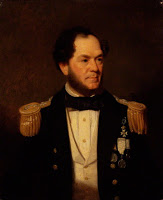
Erasmus Ommanney
The British squadron that was sent was under the overall command of Captain Erasmus Ommanney (1814 – 1904). He had been present at the Battle of Navarino when he was thirteen years old – naval careers began early in those days! He had previous experience in high latitudes as he had been second-in-command of the expedition sent in 1850 to search for Sir John Franklin and his ships Erebus and Terror which had disappeared during an effort to find the North-West Passage. It was Ommanney who discovered “fragments of stores and ragged clothing and the remains of an encampment on Beechey Island ” though no further trace could be found. Ommanney was awarded the Arctic Medal for this and he was to spend of his later years in Arctic-related scientific work, for which he was knighted. He rose to the rank of vice-admiral.
The squadron sent against Russia in 1854 under Ommanney’s command consisted of the 26-gun frigate HMS Eurydice and two near-identical steam sloops, HMS Miranda and HMS Brisk, carrying 15 and 16 guns respectively. The 910-ton, 140-foot Eurydice carried sail only and though she entered service in 1843 she was little different to frigates of the Revolutionary and Napoleonic War eras. Her ultimate fate was to be a tragic one (Click here to read a separate article about this) but at the time of the White Sea expedition that still lay some three decades in the future. All her guns were truck-mounted 32-pounder muzzleloaders, no different to those in service at Trafalgar some fifty years before.

HMS Miranda (on right) later seen in service in New Zealand waters
Though commissioned only a few years later, the Miranda and the Brisk, though also wooden-hulled, represented major technological advances. Improved versions of HMS Rattler, the first screw-driven warship in Royal Navy service, these two 1,523-ton, 196- foot vessels could make just over 10 knots maximum under steam power. This advantage was however offset by the fact that, like Eurydice, they were still armed only with 32-pounders on the broadside.
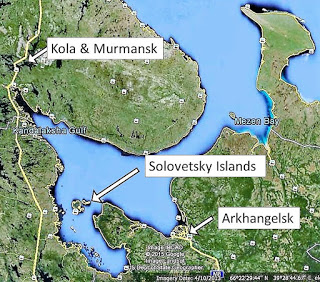
The White Sea – thanks to Google Earth
The small force arrived off the north Russian coast in July 1854 and the campaign started by advancing towards the southern end of the White Sea. Here, on a small archipelago called the Solovetsky Islands was something of a curiosity – a Russian fortress that was also a monastery. Much of this massive construction dated from the 16th century and then and in the early 17th century, it had withstood attacks by the Livonian Order (a branch of the Teutonic Knights) and by the Swedes. It is hard at this remove to understand what was thought to be gained by attacking this fortress. (In other blogs I have approvingly quoted Nelson’s dictum that “A ship’s a fool to fight a fort”).
Even had Ommanney destroyed this fortress-monastery – in itself an impossibility given the limited forces at his disposal – the strategic value would have been essentially zero. In the event, the bombardment lasted two days – 6th and 7th July. It achieved nothing and had the fort been better armed the British ships might have stood a good chance of being destroyed themselves. Two weeks later, on July 23rd, Miranda and Brisk, operating close inshore, bombarded the small town of Novitska.
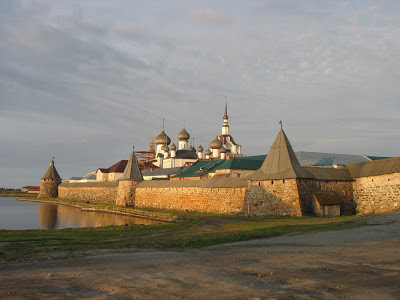
Solovetsky Fortress-Monastery in 2009 (courtesy of Wikipedia entry)

From Russian pamphlet showing bombardment of Solovetsky Fortress
The only other significant action was further west, in the Kola inlet. Miranda sailed southwards – that is upriver – towards the settlement of Kola, just south Murmansk. Here steam propulsion was a major advantage since the thirty miles distance to be covered was against a strong current and in waters sometimes so narrow that there was scarcely room to swing the ship.
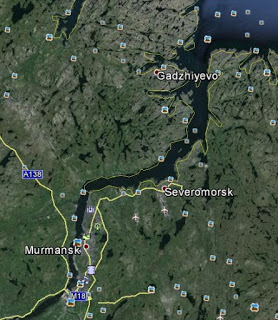
Kola Inlet today
Miranda anchored off Kola on August 23rd and under a flag of truce a demand was made that the fort there, its, garrison and all government property be surrendered. The crew remained at their stations through the night and when no answer was returned in the morning, the flag of truce was hauled down, and the Miranda, getting within 250 yards of the shore battery, opened a fire of grape and canister. This suppressed opposition enough to allow a landing party of bluejackets and marines to storm ashore. They succeeded in dislodging the enemy from the batteries and in capturing the guns. A hot fire was opened on them from the towers of a nearby monastery but its defenders were also driven out. Government stores and buildings were set on fire and completely consumed. Miranda then dropped downriver again.
That was the end of the campaign and the squadron returned to Britain. Miranda proceeded thereafter to the Black Sea to support the main Allied effort. Captain Edmund Moubray Lyons (1819 -1855), who had manoeuvred her up the Kola Inlet with considerable skill, died of wounds in June 1855. Miranda herself had an active career thereafter, mainly in Australian and New Zealand waters, and was broken up in 1869. Brisk was to have a similarly active career, most notably including service on the West Africa Anti-Slavery Patrol. She survived to 1870. The Eurydice, by then an anachronism, was to come to a tragic end in 1878. (Click here) ].
And the final verdict on the operations in the White Sea in 1854? It is easy to be critical with the advantage of hindsight, but even so one can only question why lives – both British and Russian – should ever have been squandered in such a pointless exercise. The same applies to the operation in the Northern Pacific. What, in either case, was the strategic value?
There was to be a terrible postscript. In 1923, after its monks had been murdered, the Solovetsky Monastery was to become a slave-labour camp for alleged enemies of the new Soviet Marxist state. Further camps were built on the adjoining Solovetsky Islands. As such it was to earn the unenviable name of “Mother of the Gulag” since it established a model for other camps in the vast structure of Marxist tyranny. By 1930, “about 50,000” prisoners were held there, with another 30,000 held on the nearby mainland, many of the prisoners being sent to work as slaves on construction of the White Sea to Baltic Canal. How many died at Solovetsky, as at other Gulag camps will never be known. One is reminded of the chilling words at the end of Pasternak’s Doctor Zhivago that summarise the unknown fate in the Gulag of Lara, the heroine: “She was just another name on a long list, that later got mislaid.”
We must value Freedom while we have it.
Britannia’s Gamble
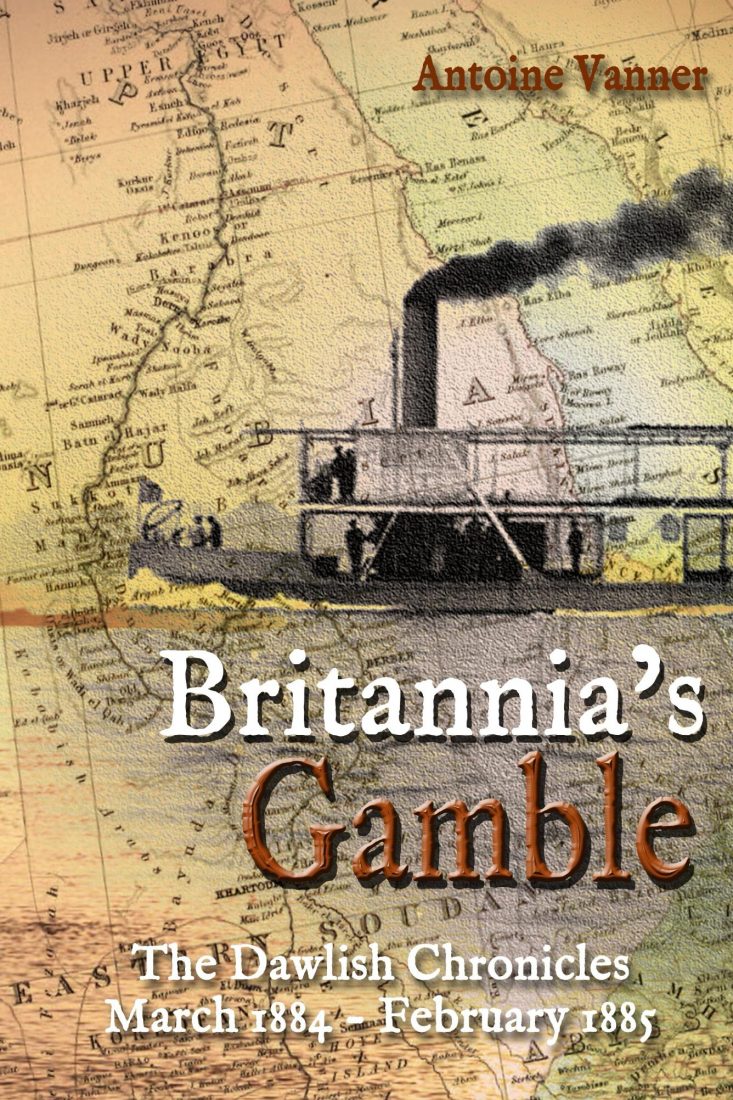 This volume of the Dawlish Chronicles is set against the background of the murderous revolt in the Sudan by the Isis of its day, and which triggered one of the most dramatic campaigns of the British Army and the Royal Navy in the Victorian era. It’s available in paperback and Kindle, and subscribers to Kindle Unlimited and Prime can read at no extra charge
This volume of the Dawlish Chronicles is set against the background of the murderous revolt in the Sudan by the Isis of its day, and which triggered one of the most dramatic campaigns of the British Army and the Royal Navy in the Victorian era. It’s available in paperback and Kindle, and subscribers to Kindle Unlimited and Prime can read at no extra charge
Extract below from review by A. Belfrage in “Historical Novels Review” – November 2018
“Some authors have so researched their period that they seem to live the events, the surroundings, the details they describe. Antoine Vanner is one of these. He breathes such life into his narrative that you would think him a correspondent in the 1880s Sudan writing what he sees, rather than a man of today looking back . . . The opening chapter is a tour de force, leaving this reader emotionally exhausted after surviving nail-biting action when wave after wave of insurgents attack the British formations. After such an opening, an author has much to live up to, but Vanner does so with aplomb, guiding the reader through the political complexities of the time while generously lacing his narrative with period detail.
Captain Dawlish finds himself commanding a desperate rescue operation that more than explains the title of the book. It is tense, gripping action at its best, enhanced by the sympathetic and introspective Nicholas Dawlish. Vanner does not shy away from the brutalities of war: some descriptions are so harrowing I had to take the odd moment before going on. But go on I must, desperate to know how this fantastic adventure would end.”
Click here, or on the cover image above, for more details
Do you enjoy naval fiction?
If you’re a Kindle Unlimited subscriber you can read any of the ten (s0 far!) Dawlish Chronicles novels without further charge. They are also available for purchase on Kindle or as stylish 9 X 6 paperbacks.
Click on the image below for more details
Six free short-stories are available for download to your Kindle. Access them by registering for the Dawlish Chronicles mailing list – just click on the banner below. You’ll be kept updated on new books and will receive other free stories at intervals.



